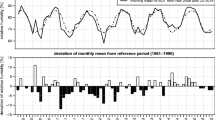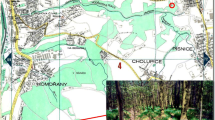Abstract
Questing Ixodes ricinus ticks were sampled monthly in a periurban mixed forest at Neuchâtel, Switzerland, in 1996, 1997, and 1998. A total of 5530 I. ricinus nymphs and 1385 adults were collected. The emergence of questing tick populations in spring varied among years in relation to the air temperature. The monthly variation in questing nymph density was negatively correlated with the saturation deficit; there was a strong decrease in tick numbers in late spring and summer as soon as the saturation deficit increased. A variation in tick density in relation to the saturation deficit was also observed between years; the tick density was high when the saturation deficit was low during spring and summer (1997) and was low when the saturation deficit was high (1998). During the 3-year study period, marked climatic differences among years highlighted the influence of temperature and saturation deficit on the phenology of ticks.
Similar content being viewed by others
Author information
Authors and Affiliations
Additional information
Received: 17 January 2000 / Accepted: 27 January 2000
Rights and permissions
About this article
Cite this article
Perret, JL., Guigoz, E., Rais, O. et al. Influence of saturation deficit and temperature on Ixodes ricinus tick questing activity in a Lyme borreliosis-endemic area (Switzerland). Parasitol Res 86, 554–557 (2000). https://doi.org/10.1007/s004360000209
Issue Date:
DOI: https://doi.org/10.1007/s004360000209




